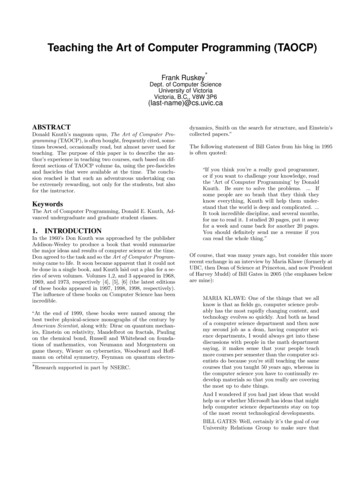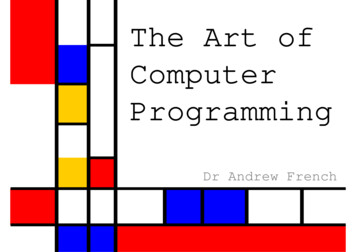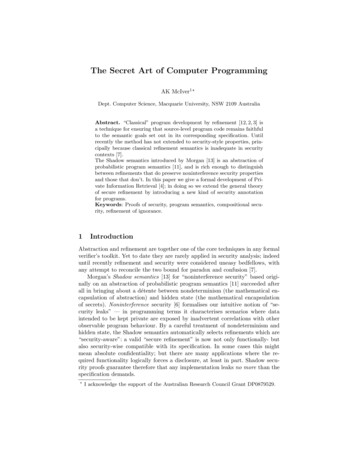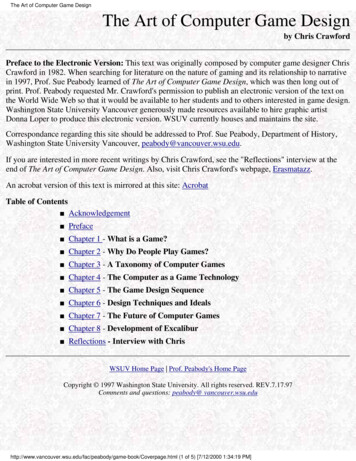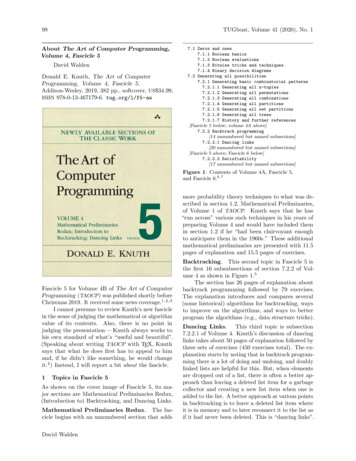
Transcription
98TUGboat, Volume 41 (2020), No. 1About The Art of Computer Programming,Volume 4, Fascicle 5David WaldenDonald E. Knuth, The Art of ComputerProgramming, Volume 4, Fascicle 5.Addison-Wesley, 2019, 382 pp., softcover, US 34.99,ISBN 978-0-13-467179-6. tug.org/l/f5-aw7.1 Zeros and ones7.1.1 Boolean basics7.1.2 Boolean evaluations7.1.3 Bitwise tricks and techniques7.1.4 Binary decision diagrams7.2 Generating all possibilities7.2.1 Generating basic combinatorial patterns7.2.1.1 Generating all n-tuples7.2.1.2 Generating all permutations7.2.1.3 Generating all combinations7.2.1.4 Generating all partitions7.2.1.5 Generating all set partitions7.2.1.6 Generating all trees7.2.1.7 History and further references[Fascicle 5 below; volume 4A above]7.2.2 Backtrack programming[14 unnumbered but named subsections]7.2.2.1 Dancing links[20 unnumbered but named subsections][Fascicle 5 above; Fascicle 6 below]7.2.2.2 Satisfiability[17 unnumbered but named subsections]Figure 1: Contents of Volume 4A, Fascicle 5,and Fascicle 6.6,7more probability theory techniques to what was described in section 1.2, Mathematical Preliminaries,of Volume 1 of TAOCP. Knuth says that he has“run across” various such techniques in his years ofpreparing Volume 4 and would have included themin section 1.2 if he “had been clairvoyant enoughto anticipate them in the 1960s.” These additionalmathematical preliminaries are presented with 11.5pages of explanation and 15.5 pages of exercises.Fascicle 5 for Volume 4B of The Art of ComputerProgramming (TAOCP ) was published shortly beforeChristmas 2019. It received some news coverage.1,2,3I cannot presume to review Knuth’s new fasciclein the sense of judging the mathematical or algorithmvalue of its contents. Also, there is no point injudging the presentation — Knuth always works tohis own standard of what’s “useful and beautiful”.(Speaking about writing TAOCP with TEX, Knuthsays that what he does first has to appeal to himand, if he didn’t like something, he would changeit.4 ) Instead, I will report a bit about the fascicle.1Topics in Fascicle 5As shown on the cover image of Fascicle 5, its major sections are Mathematical Preliminaries Redux,(Introduction to) Backtracking, and Dancing Links.Mathematical Preliminaries Redux. The fascicle begins with an unnumbered section that addsDavid WaldenBacktracking. This second topic in Fascicle 5 isthe first 16 subsubsections of section 7.2.2 of Volume 4 as shown in Figure 1.5The section has 26 pages of explanation aboutbacktrack programming followed by 79 exercises.The explanation introduces and compares several(some historical) algorithms for backtracking, waysto improve on the algorithms, and ways to betterprogram the algorithms (e.g., data structure tricks).Dancing Links. This third topic is subsection7.2.2.1 of Volume 4. Knuth’s discussion of dancinglinks takes about 50 pages of explanation followed bythree sets of exercises (450 exercises total). The explanation starts by noting that in backtrack programming there is a lot of doing and undoing, and doublylinked lists are helpful for this. But, when elementsare dropped out of a list, there is often a better approach than leaving a deleted list item for a garbagecollector and creating a new list item when one isadded to the list. A better approach at various pointsin backtracking is to leave a deleted list item whereit is in memory and to later reconnect it to the list asif it had never been deleted. This is “dancing links”.
TUGboat, Volume 41 (2020), No. 199Descriptive style. In both the backtracking anddancing links portions of the fascicle, the algorithmsand some implementation examples are presentedas sort of a verbal flow chart, perhaps includingsome instructions from Knuth’s MMIX computer andassembly language, for example:B1. [Initialize.] Set l 1, and initialize the datastructures needed later.B2. [Enter level l] (Now Pl 1 (x1 , . . . , xl 1 ) holds.) Ifl n, visit x1 x2 . . . xn and goto B5. Otherwise set l min Dl , the smallest element of Dl .This method of sketching algorithms has beenused at least since the third edition of Volume 1; however, there seem to be fewer instances of sequencesof assembly language instructions than I rememberbeing in Volumes 1, 2, and 3.8,9 As a one-time computer programmer, I wish that Volume 4A and theVolume 4B fascicles used something a little closer toa programming language for showing algorithms.There is still plenty of discussion in the fascicle of low-level ways to implement algorithms efficiently. Here is some example text from the bottomof page 65: “Interesting details arise when we fleshout the algorithm and look at appropriate low-levelmechanisms. There’s a doubly linked ‘horizontal’list of all the active options that involve it.” Thediscussion continues on the next two pages includingtwo 22x16 diagrams of the list in memory.Throughout TAOCP Knuth refers to prior volumes by section number without a volume number.5The presentation style also presumes the reader hasread the prior volumes. For example, the definitionof “visit” in step B2 above of Algorithm B is given inVolume 1 (page 320); it means “do whatever activityis intended as the tree is being traversed”.Exact cover. Early on in the discussion of dancing links Knuth also introduces exact covering. Hegives a simple example of exact covering on page 64.Suppose there are the subsets {c e}, {a d g}, {b c f},{a d f}, {b g}, and {d e g} of the set S of letters{a b c d e f g}. The first, fourth, and fifth subsetsprovide an exact cover for S, in that taken togetherthe three subsets contain all the items in S once andonly once. This is perhaps clearer if set up as findingan exact cover within a 7x6 matrix of zeros and ones(see Figure 2).With the exact cover concept introduced andpossibilities for efficient implementation discussed,Knuth then gives Algorithm X (for exact cover viadancing links), the suggestion that the reader doan exercise, and then 30 more pages of variations,applications, and 1010c101000d010101e100001f001100g010011{c e}{a d g}{b c f}{a d f}{b g}{d e g}Figure 2: A combination of Knuth’s formulas 5 and 6on page 64 of Fascicle 5; rows 1, 4, and 5 form an exactcover of the set {a, . . . , g}.Puzzles. Many puzzles are about exact covers, suchas the eight queens puzzle where the goal is to placeeight queens on a chess board such that no two queensare in the same column, row, or diagonal. Backtrackprogramming, perhaps with the help of dancing links,can often be used for finding an exact cover.(While describing backtracking, Knuth had already noted that one of the best ways to understandbacktracking is to execute the basic backtrackingalgorithm, Algorithm B, by hand for the four queenspuzzle — placing four queens on a 4 by 4 chessboardso no queen attacks any other queen. I spent abunch of time doing this, and it helped me understand both backtracking and the potential subtletiesof implementing it in code.)As the dancing links discussion continues, Knuthdevelops various algorithms and presents some theorems, often using puzzles as illustrations, e.g., sudoku,polyominoes, and kenken. Knuth chats about this inthe fascicle’s preface. He sees puzzles as often beingthe best way to illustrate an algorithm. The oddsare good, he says, that a page selected at randomin the fascicle will mention a puzzle. He makes thepoint that the methods that he is describing are useful for creating puzzles as well as solving them. Healso discusses the history of the puzzles and sees thefascicle as a contribution to the world of recreationalmathematics as well as teaching computer methods.Knuth has said that Volume 4 covers the kindof algorithms he enjoys most.11 A quote from theFascicle 5 preface: “I have had loads of fun writingthe other fascicles, but without a doubt this one hasbeen the funnest.”I do wish, in addition to all the puzzle examples,that the fascicle spent more time on real world applications. On the Internet,12 I found the followingstatement, which helped me somewhat:By far the most relevant, large size, important application of set covering is in personnel shift planning (mainly in large airline companies). There,elements to be covered are the single shifts (orsingle flights), and sets are legal combinations ofAbout The Art of Computer Programming, Volume 4, Fascicle 5
100TUGboat, Volume 41 (2020), No. 1work/no work schedules. These easily go to millions or even billions of variables, as the numberof combinations is huge.I guess I comprehend that the general topic ofVolume 4, combinatorics, is relevant to a wide varietyof real life problems.Knuth lectures. If you haven’t yet bought thebook and want to know more about dancing links,Knuth’s 2018 Christmas lecture is on the topic,13and there is a previous (2000) Knuth lecture also ondancing links.14 Notice that these two lectures on thesame topic are years apart; Knuth states in Volume4A that he has been saving up various methods andexamples for years to eventually select among themfor Volume 4 of TAOCP. (He also emphasizes thatthere is much he doesn’t cover; he has to “cut, cutcut”, keeping only what he believes will remain offundamental importance for decades.)Knuth’s 2019 Christmas lecture15 is nominallyabout π; among other things, he gives a bunch ofexamples of π being used in his books as a sourceof random data. In the lecture Knuth also talksabout Fascicle 5, gives examples (especially puzzleexamples) from the fascicle, and promotes it (“itwill be a good Christmas present”). Talk aboutVolume 4B starts at about minute 27 of the lecture’svideo, first with a bit about Fascicle 6 and then aboutFascicle 5. Giving example after example of sudoku,Knuth says that he has studied sudoku so deeply, itis no wonder it took him a long time to write thebook. He has said that this book is “tons of fun andteaches a few algorithms on the side”.16There is also a Knuth video on the subject ofFascicle 6, satisfiability and SAT solvers.17 Figure 1shows where Fascicle 6 fits within the topics of Volume 4 of TAOCP. Volume 4A discusses manipulationof 0s and 1s and methods of generating basic combinatorial patterns; Fascicle 5 discusses backtrackingand how to do it more efficiently with dancing links;and then Fascicle 6 on satisfiability shows the use ofthose techniques to develop SAT solvers which canbe applied to many, typically massive, real worldproblems. Knuth touches on some of the latter inthe video. In the Preface to Fascicle 6, Knuth says,“The story of satisfiability is a tale of the triumphof software engineering blended with rich doses ofbeautiful mathematics.” For any readers who havebeen wondering if Knuth’s emphasis on efficient algorithms is still relevant with today’s computers whichare so much more powerful than in 1962 when Knuthstarted TAOCP, Fascicle 6 justifies the continuingthrust for maximum efficiency. Knuth reports that“modern SAT solvers are able to deal routinely withpractical problems” involving “many thousands ofDavid Waldenvariables” that were “regarded as hopeless just a fewyears ago”. In Fascicle 6 he is describing a rapidly developing field — especially over the past few decades.Knuth has been actively learning and contributing tothe field in various ways, but he says that he knowshe must move on. Fascicle 6 is a 2016 snapshot ofthe field, leaning toward the implementation ratherthan theoretical side of things; and Knuth hopes thatit contains a “significant fraction of concepts thatwill prove to be the most important as time passes”.2Main text, exercises, and answersFascicle 5 is definitely an unusual book (althoughnot so much for Knuth) in terms of the ratio ofmain text to exercises and answers. Fascicle 5 has100 pages of main text, 88.5 pages of exercises (663exercises total), and 176 pages of answers. Knuthsays that he wrote 600 programs while writing thisfascicle because he needs to program things to reallyunderstand them. A small set of the most importantprograms are available, written in CWEB, to helpreaders solve problems.Digressing for a moment to Fascicle 6 (section7.2.2.2, on satisfiability — see Figure 1), it has 132.5pages of main text, 50.5 pages of exercises (526 exercises total), 106 pages of answers, and 310 pagesaltogether in the book. This gives us, so far inVolume 4B, 232.5 pages of main text, 139 pages ofexercises (1,189 exercises), and 282 pages of answers.In his Notes on the Exercises near the beginningof TAOCP Volume 4A, Knuth explains about thebenefits of exercises, noting that the exercises allow(are designed for) “self-study as well as for classroomuse.” He continues, sayingIt is difficult, if not impossible, for anyone to learna subject purely by reading about it, withoutapplying the information to specific problems andthereby being encouraged to think about whathas been read. Furthermore, we all learn bestthe things that we have discovered for ourselves.Therefore the exercises form a major part of thiswork; a definite attempt has been made to keepthem as informative as possible and to selectproblems that are enjoyable as well as instructive.Knuth has had this view a long time. I remember that in Knuth’s interview in the book Mathematical People,18 he said that when first in collegehe had doubts about his abilities. Therefore, heworked all the exercises in the textbook, not just theassigned exercises, and then found he really understood things. Also there was his problem solvingcourse at Stanford: people we know who took thiscourse said it was wonderful — the teacher and students jointly solved new problems with the teacher
TUGboat, Volume 41 (2020), No. 1101using his experience to guide the students in usefuldirections.193What TAOCP is and isn’tI previously spoke to what TAOCP is and isn’t: seemy 2011 “appreciation” of Volume 4A in TUGboat.20I will repeat a couple of points here because therehas been a lot of overstatement about TAOCP inthe popular press which is all many lay people knowabout
About The Art of Computer Programming, Volume 4, Fascicle 5 David Walden Donald E. Knuth, The Art of Computer Programming, Volume 4, Fascicle 5. Addison-Wesley, 2019, 382 pp., softcover, US 34.99, ISBN 978-0-13-467179-6. tug.org/l/f5-aw Fascicle 5 for Volume 4B of The Art of Computer Programming (TAOCP) was published shortly before Christmas 2019.




